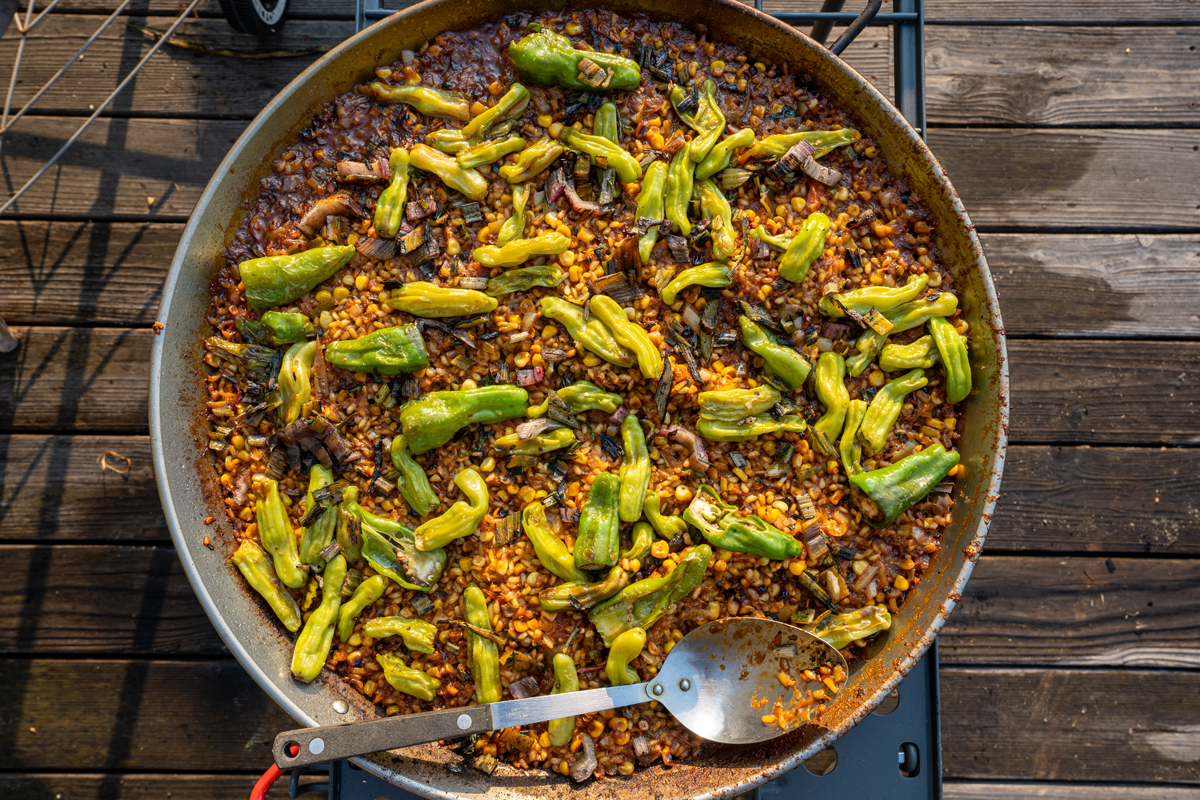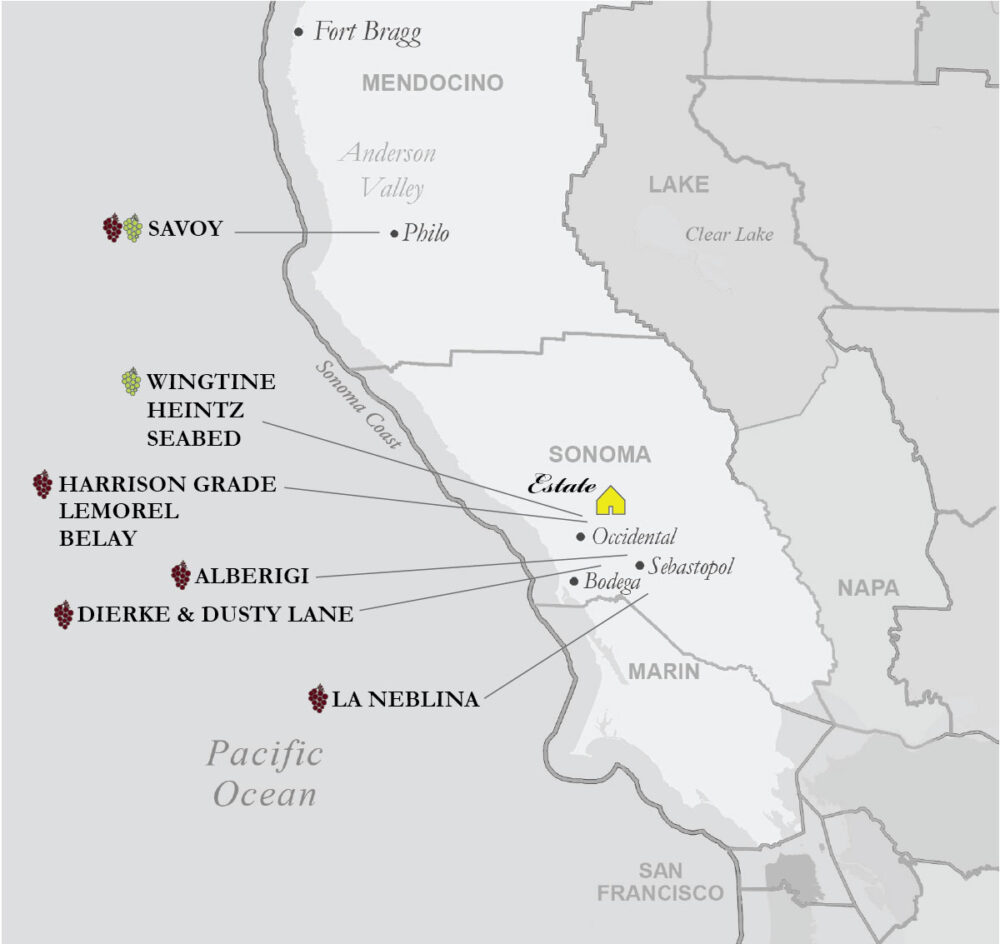2021 Fall Flavors
Harvest Paella
by Harry DiPrinzio | Chef de Cave
Featuring wines from the Radio-Coteau 2021 Fall Release and vegetables from the Biodynamic Estate Vineyard & Farm.

A week ago, I told Eric I would be glad to cook paella for our small team to celebrate the start of our 20th harvest.
Paella has the virtue of being flexible, relatively easy, impressive, and incredibly delicious. As our varied pairings that day attest, paella goes well with a wide array of our food-friendly Fall Release wines. Smoked paprika finds complements in our Estate Syrah and Proprietary Red, while the SeaBed Estate Chardonnay will shine next to acid-driven tomato sofrito and briny shellfish.
The wisdom of cooking in large vessels to feed a group is evident in the dish, as is the wisdom of using the ingredients you have around to create something delicious. Regional and seasonal variations of the Iberian specialty abound, featuring all types of seafood, game, fresh and cured meats, and vegetables.
Purists will insist on using Bomba rice, the short grain variety grown in Spain that can absorb a large amount of liquid without bursting, maintaining its structure and bite. The virtues of this are true, but other short grain varieties such as Spanish Valencia, Arborio, or even short grain sushi rice could be substituted.
Purists will also insist on saffron and paprika. However saffron, while an awesome ingredient (that grows locally due to our moderate Sonoma climate), is optional. Smoked (both sweet and spicy) paprika goes a long way toward giving the dish its typical character, but I think Mexican chipotle (also smoked), ground cumin and turmeric, or Korean gochugaru would equally satisfy.

On the Estate, our sweet corn and shishito pepper crops are currently go-to components for our vegetable paella. Yet peas, fava beans, grilled green onion, currants, pine nuts, grilled mushrooms, or roasted winter squash are some examples of variation throughout the seasons. Sturdier vegetables like corn and squash should be cooked in advance. Delicate ones can be cooked in the rice.
For our meat paella, we used a selection of northwestern shellfish, locally raised chicken, and Spanish chorizo. Anything goes though…fresh sausage, shrimp, rock cod, spiced ground beef, braised lamb, or cured Italian salumi. Ideally, use meat that’s raised outside with room to roam, or sustainably harvested seafood. Cook it in the pan first and save the fat to cook your sofrito and rice.

Vegetable stock can be bought or easily made from a collection of a week’s worth of vegetable scraps. (Store them in a Ziplock bag in the freezer while they accumulate.) Finding a whole chicken and using the carcass to make stock for your paella is an elegant efficiency.
Paella pans can work directly over a charcoal or gas grill. In either case, the fire should be medium hot – enough to sauté, but gentle enough that you can cook your rice through without burning.
With rice, extra protein, and vegetables, paella doesn’t need much else on the table. Serve with a toasty white bread (in our case topped with chopped fresh tomato and dressed with sherry vinegar), a green salad, and plenty of wine.
Harvest paella, both meat/seafood and summer vegetable versions
(Serves 8)
- 14-20 inch paella pan
- 4 cups short grain white rice, preferably Spanish
- 1 tsp paprika, smoked
- 1 tsp paprika, sweet
- pinch saffron (optional)
- about 5 quarts stock: vegetable, meat, or seafood, seasoned with salt
- 8 cloves garlic, chopped coarse
- salt & pepper to taste
- olive oil as needed
- 1 lemon, thinly sliced for garnish
Sofrito (carmelized onion and tomato base):
- 3 onions, finely chopped
- 1 mild green bell pepper, finely chopped
- 4 cups tomato puree
- glug of olive oil (about 2 Tbsp)
Summer vegetable paella:
- 3 ears sweet corn, removed from the cob
- 4 cups shishito peppers
- 1 cup grilled swiss chard stems, sliced thin
Meat & seafood paella:
- 2 chicken thighs, deboned
- 2 chorizo sausages, sliced 1 cm thick
- 10 Manila clams
- 10 mussels
1. Preheat a gas grill to hot or prepare a medium hot fire.
2. Place stock in a large pot and heat to simmer.
3. Pre-cook paella additions:
3a. For meat paella: Season chicken with salt and pepper. Using your paella pan, over medium/high heat and enough oil to coat the pan, brown chicken to cook through, rotating from skin to back. Cook sausage through, rendering fat. When done, set meat aside and if the rendered fat is not burnt, leave it in the pan for the sofrito and rice. Otherwise, clean pan for the paella.
In a separate frying pan, heat a small amount of oil until it shimmers. Add cleaned mussels and clams to the pan and cover. Cook over high heat until the shells open up. Some wine or water can be added to the pan if all liquid evaporates before the shells open.
3b. For vegetable paella: Add a generous amount of oil to the paella pan and let heat until it shimmers. When very hot, add corn to the pan and stir so corn is coated in oil and evenly distributed. Season with salt and ground black pepper and let cook for 2-4 minutes without moving, to allow for caramelization. Check the corn on the bottom of the pan for color. If caramelization is occurring, stir the pan, making sure to fully scrape the bottom to rotate the corn, otherwise let it be. The corn will tell you it is getting done when kernels start popping out of the pan. Don’t be alarmed! Instead, let cook 1-3 more minutes before removing and setting aside. If corn has stuck to the pan at the end, deglaze with 1/2 cup water or white wine and incorporate into corn.
In the same pan, heat oil over medium-high heat until hot. Add shishito peppers and toss to coat with oil. Distribute the peppers evenly throughout the pan and cook for 1-2 minutes until they begin to develop color. Toss and repeat before removing the peppers from the heat when they are tender and have developed color throughout. Set aside and season with salt.
4. Make the sofrito: Coat your paella pan with a generous amount of olive oil. While cool, add onions and bell pepper. Season with salt and cook, stirring frequently, over low heat until onions are soft and translucent, and sugars are condensed – approximately 30 minutes.
5. Add garlic, paprika, and then rice, stirring to coat everything in oil and distribute heat evenly. Add more oil if needed.
Add cooked meats or vegetables (chorizo, chicken, corn).
When you smell rice toasting, add the tomato puree and incorporate. Distribute saffron throughout pan and simmer until tomato mixture is no longer wet.
6. Incorporate 1/2 the stock, stirring the pan to distribute liquid and spread rice in a uniform layer across the pan.
Simmer until stock is absorbed without stirring rice, adjusting pan if necessary, for even and gentle heat.
Continue to add stock as it is absorbed or evaporates, tasting to tell when the rice is cooked. When rice is soft and just al dente, lower the heat and distribute seafood or shishito peppers throughout.
7. For the socarrat (the prized crispy rice on the bottom of the pan): When the liquid at the bottom of the pan has been absorbed, the rice will crackle as it crisps. It will continue to do so as more liquid is absorbed and the bottom layer of rice fries, but will go silent when it beings to burn. As your rice is getting to creamy doneness, listen for the crackling and test the crispness of the crust with a spoon accordingly, using gentle heat to continue socarrat development. Remove from heat when you have crispy rice at the bottom of your pan and serve directly from the pan.
Garnish with sliced lemons and enjoy alongside your favorite Fall Release wine.


